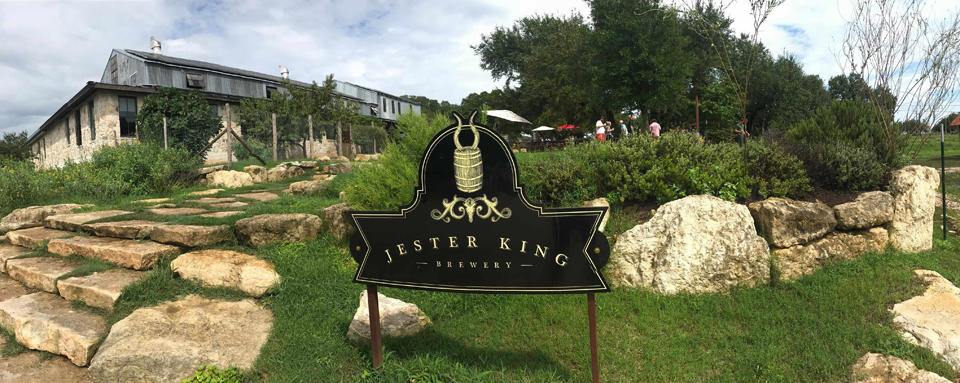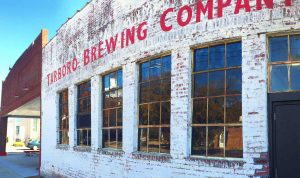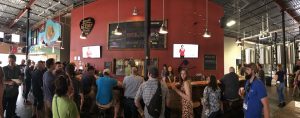
Jester King “Farm Brewery” in the Texas Hills is a beautiful and delicious place to savor inventive southern craft brews
Some of America’s best and most inventive craft brewers are coming from the southern states, a part of the country that historically lagged most regions when it came to building a beer culture. Do you ever wonder how the region’s craft brewing scene, which arrived late to the game, developed relatively fast and so well?
Franklin Winslow, once head brewer at Philadelphia’s Yards Brewery (and a North Carolinian by birth), used to tell me that one of the reasons Americans were so innovative about beer — creating the craft scene —was that we really had no deep brewing roots of our own.
All the early American beer traditions and brewers came from other countries. So once truly American brewers evolved, they could do whatever kind of brewing they wanted. There was no “Reinheitsgebot,” the German purity law, or other “rules” to restrict brewers’ imaginations in the U.S. like those in Europe.
Is it possible that the deep South’s beer scene is a microcosm of that very American advantage?
Let’s take a look at what made South’s brewing culture very different from other regions. We must look back at the development of America’s culture to really understand it.
Many believe four major historic contributors created a unique drinking culture in the South:
- The impact of immigration from Europe, particularly Germany, was minimal in the South compared to most all of the rest of the country in the 1800s;
- As a result, there was less comfort with the more casual European drinking and brewing culture, and acceptance by followers of established religions;
- The South historically experienced less Industrialization than the rest of the U.S., so there were fewer factory workers who are more apt to drink beer communally than their more agrarian brothers;
- Increasing mechanization in the North created more jobs and growing wages, which could be spent outside of the home.
Consider how the German influx in the 1800s influenced America. Simply look up “German Americans” on Wikipedia and you will see where the Germans settled and brought their culture of beer and brewing as a normal part of life.
More than 7.5 million Germans immigrated to the United States between 1820 and 1870 — more than doubling the country’s population. Few of those immigrants went south, so their heritage wasn’t infused into the region’s culture. As a result, early commercial brewing as a regular part of life flourished in the Northeast and Western U.S.
Today, census figures show that people of German descent make up less than a tenth of the population in every deep southern state. In comparison, a quarter of residents in Pennsylvania, Ohio and states further west can claim some degree of German heritage. Those numbers approach 40% in states such as Illinois and Wisconsin.
More homogenous religious practices in the South — typically Protestant — tended to generate a distrust of unfamiliar European practices such as drinking outside, consuming beer with women and children present and imbibing on Sundays. The South still has more than a few dry towns and counties today. Many so-called “blue laws,” which restrict everything from drinking to even selling cars on Sundays, are common in some counties.
Early agrarian economies in the South created longer distances between people and less disposable income. Because there were very few accessible breweries, there was less beer to share. People would often drink at home, and with a few friends, after a long day on the farm, and they would often make their own alcohol — typically beer or whiskey — for that purpose.
While beer certainly existed in the South — recipes from George Washington and Thomas Jefferson are well chronicled — pubs and bars weren’t the significant social centers like they were in the growing cities of the North. Taverns existed, though they primarily served as a necessary stop for weary travelers, though libations often were a critical part of the stay.
It seems clear that these influences and others — brewing in hotter climates adds its own unique set of challenges — stunted the popularity of beer and brewing in the South.
An obvious example: When President Jimmy Carter made home brewing legal in 1978, several Southern states still prohibited it. Mississippi and Alabama didn’t relax their rules until 2013. I think most people would agree that there is a direct link between the growth of home brewing in the U.S. and the evolution and growth of craft brewing.
The good news is that an interest in beer and brewing finally came to the South. Once it did the craft exploded and blossomed like nowhere else in the country. Rootlessness means no rules, right? No “traditions” have to evolve and change, and there are no past industry leaders to have to emulate and pay homage to.
Most of the craft breweries that opened in the Northeast in the 1980s first started offering the public the “big four” European beer styles: blonde, amber, pale and porter/stout. They were predominantly straightforward ales, with an occasional nod to the German wheat beer, with a lager introduced from time to time. The old-style European pub was the model of the first brewpubs, a far cry from the tap room and massive craft beer bars we have today.
Southerners who visited other regions in the 1980s and early 1990s must have felt like the Americans who visited Europe in the 1950s, drank beer with real flavor and wondered “why can’t we have that in the U.S.?” They must have been as excited and opined about the future of their region’s beers. That change would happen, but in its own way.
The new Southern beer culture helped pave new ways to serve craft beer. If you look into the origins of the huge 50 to 100 craft tap room chain restaurants — most came from the “no rules” South.
One of the very first was “Taco Mac,” a chain started in Atlanta in the early 1980s, startling Southern beer appreciators with dozens of beer choices at a time when little craft was available in the region. Then there was the “Flying Saucer” from Texas in 1995, and the “World of Beer” from Tampa, Fla., in 2007; each offering hundreds of beers to try.. All of these chains still exist, with most outlets still below the Mason-Dixon Line, introducing southern beer enthusiasts to regional and other brands.
I don’t mean to suggest that the Deep South was a complete wasteland for craft beer. For example, the “artisan community” of Asheville in western North Carolina has been a craft beer destination for years. Highland, the city’s first brewery, opened in 1994, and was followed by Green Man in 1997. The popular Wicked Weed was a trend setter with “wild ales”, which we all know is now an Inbev brand. (See my blog post on Macro’s buying Micro’s here.)
The Asheville scene has continued to grow, with roughly 60 breweries in the area, shifting the conversation from “is there a need” to “is there oversaturation”? But that is a discussion to be had at another time.
The recent establishment of Sierra Nevada’s East Coast outpost adds to Asheville’s craft beer heritage. But consider that, at the time the first brewery in Asheville started, Sam Adams had already been around for a decade. Five years before that, California counter-culturists like Fritz Maytag were selling craft, including his Anchor Steam Beer.
One notable very early brewery located in the south – Spoetzl, in Shiner Texas has a great story. The way I heard it, the Spoetzl family was one the relatively rare German families to migrate to the south in the late 1800’s – lured all the way to Shiner Texas by an offer of a land grant by the US government – who was desperate to settle the Texas territory to keep it out of Mexican hands. They built their brewery in 1907 to support the German farmers trying to carve out a living in that rugged earth. Shiner Bock can now be found in bars all over the nation.
Now in the South, we have many, many wonderful breweries, with inventive beers and flavors, including hop bombs from breweries like Burial and Heist; Lambics and other sours; and barrel-aged masterpieces —anything you can imagine. They are popping up en masse, spreading across metropolitan areas and small towns. Beer is flowing across the south from breweries such as Yazoo in Nashville, Against the Grain in Louisville and Westbrook in Charleston. Even Mississippi, which arrived late to the game, can claim Lazy Magnolia among its brewing treasures.
Sometimes craft still collides with local alcohol rules, creating the need for inventive work arounds for the southern brewer. For example, in Tennessee there was a law that dictated that any beer with the alcohol level over 6.2% couldn’t be sold without a liquor license. This didn’t stop the folks such as Black Abbey Brewing in Nashville, who brewed a delicious line of Belgian-inspired brews that conveniently topped out at 6.1%. Can you say “Monk Lite”?
Now tailgating with Bud Light competes with communal local craft beer tap rooms, and community focused brands are becoming a source of local pride. Southern communities are embracing not only locally brewed beer but the once-abandoned factories and shops that are being reimagined as microbreweries and tap rooms — just like what occurred in the Northeast and Western U.S.
It seems likely, thanks to a lack of traditional European brewing history and traditions, styles and rules, craft beer is happening faster in Dixie, and more inventively that one could have rightly imagined.
Thanks to Paul Davis, N.C. Beer Guru and Writer for his contributions to this article.









